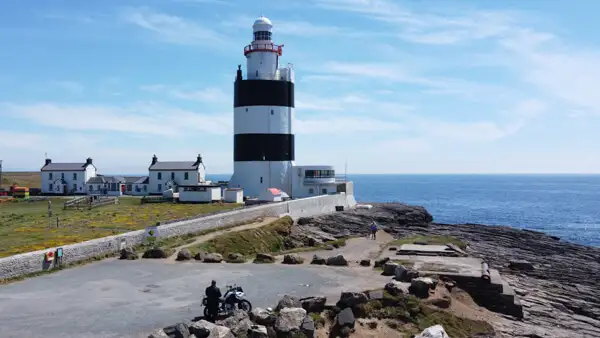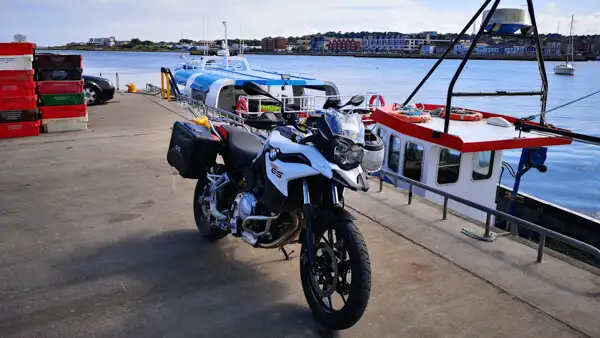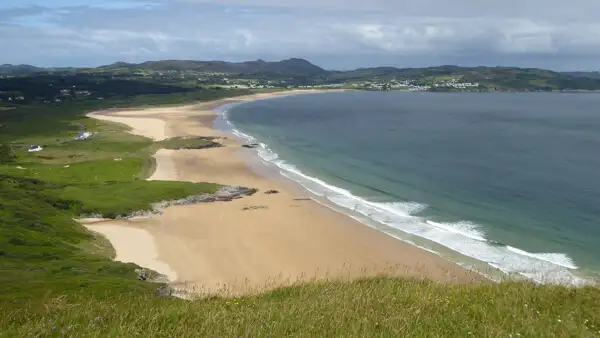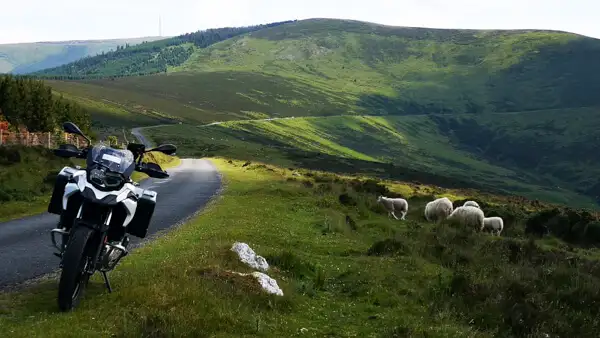If you are thinking about a holiday in Ireland by motorbike but still have a lot of questions, then you have come to the right place!
Page Contents (click line to jump the text)

Intro
We have our second home in Ireland, coming from Germany. We had our own motorcycle rental shop here for a number of years.
Many of our guests have questions about Ireland, travel information, motorcycling, left-hand driving and much more.
I have summarised and answered some typical questions for you here – let’s get started:
Is Ireland part of Great Britain?
The Republic of Ireland, which makes up most of the island of Ireland, is fully independent and a member of the EU. Northern Ireland, in the north-east of the island, is still part of Great Britain, but there are always talks about a merger/reunification with the Republic. By the way, the green borders are completely open, so you can travel from Ireland to Northern Ireland and back without any problems.
What currency is used in Ireland?
The Republic of Ireland uses the euro. Northern Ireland has the Northern Irish pound, which is the same as the English pound.
What language is spoken in Ireland?
There are two official languages, both of which are also taught in schools: English and Irish, the Gaelic language of Ireland, which is still actively spoken, especially on the west coast.
Are the Celtic languages all the same?
The Celts had several dialects from which regionally different languages developed. Irish (Gaelic) most closely resembles Manx, the Gaelic language on the Isle of Man. The Gaelic languages in Wales and Scotland are somewhat different, the difference being roughly comparable to German and Dutch. There is also another Celtic language on the mainland: Breton, which is still spoken in Brittany in France.
What is the mains voltage in Ireland?
Ireland and Northern Ireland use 230 alternating current, just like Germany. However, Ireland and Northern Ireland have the English three-pin plug, so you will need a travel adaptor for your appliances when you travel.

What documents do I need to enter Ireland?
Ireland is in the EU, but not in the Schengen Agreement. Therefore, you will need a valid passport to enter the country. You should take this with you anyway if you plan to travel to Northern Ireland.
Can you drink the tap water in Ireland?
Yes, the drinking water quality in Ireland is good. The Irish groundwater is even significantly less contaminated by nitrates and thus cleaner than in (my home country) Germany (just for comparison).
On which side of the road do the Irish drive?
Ireland drives on the left, just like Northern Ireland and the British Isles. This often seems exotic to Germans, but in fact about half the countries in the world have left-hand traffic.
Is it easier to learn to drive on the left by car or motorbike?
Riding a motorbike will be much easier for you. At first it is a bit unusual to drive in the middle of the left lane, but with a motorbike you have more space on the often narrow roads than with a car. In addition, all the switches are always in the same place on the motorbike.
In Irish rental cars you sit and steer on the right and change gears with your left hand. This is just as unusual as driving a German car on the left side of the road.
What is the weather like when travelling in Ireland – does it always rain in Ireland?
Not all the time, but every now and then. In terms of rainfall, it’s roughly comparable to northern Germany. Especially on the west coast it can be changeable. Then there are short showers every now and then. Persistent rain and very stormy weather are more common in the winter months.
What are the travel temperatures like in Ireland?
The Gulf Stream provides the coasts of Ireland with comparatively warm water and has a balancing effect on the climate. In winter, Ireland is somewhat milder than Germany. There is hardly ever frost, and if there is, then only briefly.
In summer it is warm, but rarely hot. In July you can expect 20-25 degrees Celsius, but not over 30 degrees. In early summer and late summer it’s more like 15-20 degrees.

Is Ireland an expensive destination?
There are many cheap flights from German airports to Dublin – provided you book in time. Ferries are rather expensive, especially in the summer months.
Overnight stays (double room for single use) in B&Bs are around €80-110 per night, mid-range hotels are more like €100-140 per night. There are also homestays, hostels and campsites that are much cheaper.
Food in the supermarket is on average as expensive as in Germany. Dinner in a pub is usually very good and not expensive, comparable to a German country inn. Meat in particular is usually cheaper in Ireland than in Germany and of the best quality.
What does that mean on average? You will have a similarly cheap or expensive holiday in Ireland as in Germany (for comparison).
Does Ireland also have mountains?
Oh yes, very beautiful ones! They go up to about 1000m and are comparable in height to German low mountain ranges (e.g. the Black Forest).
However, only in terms of height, because in appearance they often look more like the Scottish Highlands. That is, bare hilltops, high moors, rocks, heather and peat.
There are several low mountain ranges on all coasts, while the inland is rather flatter.
Where are the most beautiful places in Ireland?
There are many beautiful areas, but the Wild Atlantic Way is definitely the highlight of Ireland. This is a network of coastal roads that stretches over 2500km from the south coast, along the west coast to the northern tip of the island.
This makes the WAW the longest coastal road in Europe. Especially the wild Atlantic coast in the west has spectacular cliffs rising several hundred metres from the sea and is truly breathtakingly beautiful!
How many inhabitants does Ireland have?
Ireland has a population of just over 5 million. Of these, just over 2 million live in and around Dublin, Cork has about 210,000 inhabitants and Galway has about 84,000. Those were the three largest cities in Ireland. Apart from that, there are still many small and micro towns and villages. The population density is much lower than in Germany, especially in the countryside.
Is there a lot of traffic in Ireland?
Compared to Germany, there is very little traffic in Ireland. This is due to the low population density. Exceptions are Dublin, Cork and maybe Galway, where more people live. In the countryside, you can ride your motorbike in complete peace with very little traffic.
However, there are many tourists in Ireland, especially in the summer months. Statistically, there are about 10 million a year. Many of them will only visit Dublin, in summer and winter. But many can also be found on the west coast in the summer, so popular places like the Cliffs of Moher can get crowded. In early summer and late summer, however, this is not a problem.

What are the speed limits in Ireland?
The speed limit is 120kmh on motorways, 100kmh on national roads (N) and 80kmh on smaller country roads (R and L), which you often can’t drive at all because the road is too narrow and confusing. In built-up areas, 50kmh is permitted.
What are the speed limits in Northern Ireland?
In Northern Ireland, the speed limit is miles per hour, the same as in England. In built-up areas this is 30 mph (about 48kmh) on rural roads 60mph (about 96kmh) and on motorways 70mph (about 112kmh). Roads in Northern Ireland are generally well maintained, but on small country roads in rural areas it can get narrow and “bumpy” again.
What are the roads like in Ireland?
Motorways in Ireland are generally well maintained, as are many National Roads (N). However, you should avoid these if possible, as they are usually not very interesting.
Most of the time you will be on Regional Roads (R) and Local Roads (L). These are usually very narrow, often lined with hedges and walls and therefore confusing and not always in good condition.
What does this mean? If your bike has good suspension, that’s an advantage, if it’s handy and manoeuvrable, the same. You’ll be riding very slowly on average, so engine power doesn’t matter at all. The daily distances of our customers are on average about 200km/day. A distance of 250-300km is already a very long driving day.
Finally
Many motorcyclists do not have Ireland “on their mind” or shy away from the left-hand traffic or other reasons due to insecurity. This is a pity, because the Irish island offers the most beautiful motorcycling! Our clients are regularly thrilled and many come back again to ride a part of the island they didn’t get to the first time.
I hope I could answer some of your questions and wish you a great motorbike tour in Ireland. And if you are still looking for a rental motorbike for your trip, you can find us here: www.easycruiser.tours.
More interesting articles for you
THE 13 MOST BEAUTIFUL MOTORBIKE TOURS ON THE IRISH ISLAND
HOW MUCH DOES A MOTORBIKE HOLIDAY COST IN IRELAND?
MOTORBIKE TRIP IRELAND – WHICH REGION SHOULD I GO TO?
EXPERIENCING IRELAND BY MOTORBIKE, OR: THE REDISCOVERY OF SLOWNESS
Photo credits cover photo: Ulrich Knüppel-Gertberg (www.irland-insider.de, www.ireland-insider.com)